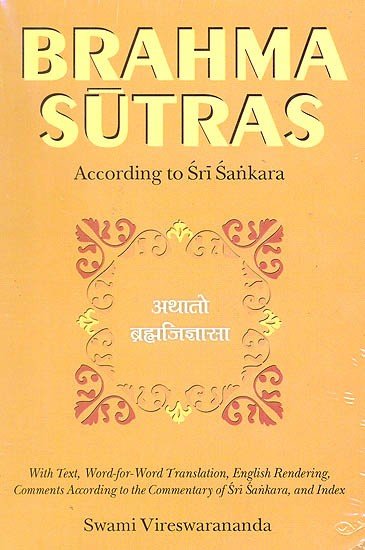Brahma Sutras (Shankara Bhashya)
by Swami Vireshwarananda | 1936 | 124,571 words | ISBN-10: 8175050063
This is the English translation of the Brahma-sutras including the commentary (Bhashya) of Shankara. The Brahma-sutra (or, Vedanta-sutra) is one of the three canonical texts of the Vedanta school of Hindu philosophy and represents an early exposition the Vedantic interpretation of the Upanishads. This edition has the original Sanskrit text, the r...
Chapter III, Section III, Adhikarana XXXVI
Adhikarana summary: Meditations connected with members of sacrificial acts may or may not be combined according to liking
Sutra 3,3.61
अङ्गेषु यथाश्रयभावः ॥ ६१ ॥
aṅgeṣu yathāśrayabhāvaḥ || 61 ||
aṅgeṣu—With regard (to meditations) connected with members (of sacrificial acts); yathā-śraya-bhāvaḥ—it is as with (the members) with which they are connected.
61. With regard (to meditations) connected with members (of sacrificial acts) it is as with (the members) with which they are connected.
Sutras 61-64 give the view of the opponent. Different instructions connected with a sacrifice are mentioned in the different Vedas. Now the scriptures themselves say that all these members mentioned in the different Vedas are to be combined for the due performance of the main one. The question now is, what is the rule to be followed with respect to the Upasanas connected with these members ? This Sutra says that the same rule which applies to the members applies also to the Upasanas connected with them. In other words, all these Upasanas are also to be combined.
Sutra 3,3.62
शिष्टेश्च ॥ ६२ ॥
śiṣṭeśca || 62 ||
śiṣṭeḥ—From the injunction of the Sruti; ca—and.
62. And from the injunction of the Sruti.
Even as the members are scattered in the different Vedas, so are also the meditations connected with them. There is no difference as regards the injunction of the Sruti with respect to these meditations.
Sutra 3,3.63
समाहारात् ॥ ६३ ॥
samāhārāt || 63 ||
63. On account of the rectification.
A further reason is given by the opponent.
“Now verily that which is Udgitha is ‘Om’, and that which is ‘Om’ is Udgitha. (If one knows this) then from the seat (i.e. through proper functioning) of the Hotri (he) rectifies all defective singing (of the Udgatri)” (Chh. 1. 5. 5). Here it is said that the mistakes committed bv the Udgatri (chanting priest of the Sama-Veda) are rectified by the recitation of the Hotri (invoking priest of the Rig-Veda), which shows that the meditations, though they are given in the different Vedas, are yet interlinked. So all of them have to be observed.
Sutra 3,3.64
गुणसाधारण्यश्रुतेश्च ॥ ६४ ॥
guṇasādhāraṇyaśruteśca || 64 ||
guṇa-sādhāraṇya-śruteḥ—From the Sruti declaring the feature ‘Om’ as being common to all the Vedas; ca—and.
64. And from the Sruti declaring the syllable ‘Om’ which is a common feature (of the Udgitha Vidya), to be common to all the Vedas.
“Through this does the Vedic Vidya proceed” (Chh. 1. 1. 9). This is said with reference to the syllable ‘Om’, which is common to all the Vedas and all the Upasanas in them. This shows that as the abode of all Vidyas is common, so are the Vidyas that abide in it, and therefore all of them are to be observed.
Sutra 3,3.65
न वा, तत्सहभावाश्रुतेः ॥ ६५ ॥
na vā, tatsahabhāvāśruteḥ || 65 ||
na vā—Rather not; tatsahabhāva-aśruteḥ—their correlation not being mentioned by the Sruti.
65. (The meditations connected with members of sacrificial acts are) rather not (to be combined), as the Sruti does not say that they are so correlated.
This and the following Sutra give the conclusion. The rule for combining the instructions regarding sacrifices that are scattered in all the Vedas cannot be applied with respect to the Upasanas connected with them. In the former case, if the instructions are not combined, the sacrifice itself will fail. But not so if the Upasanas are not practised, for Upasanas only enhance the results of the sacrifice. (Vide 3. 3. 42). They are not inseparable from the sacrifice. So they may or may not be practised.
Sutra 3,3.66
दर्शनाच्च ॥ ६६ ॥
darśanācca || 66 ||
darśanāt—Because the Sruti says so; ca—and.
66. And because the Sruti says so.
“The Brahman (superintending priest) who knows this protects the sacrifice, the sacrificer, and all the other priests” (Chh. 4. 17. 10). This shows that the scriptures do not intend that all the meditations should go together. If it were so, then all the priests would know all of them and there is no sense in the Sruti distinguishing the qualified superintending priest from the rest.
The meditations, therefore, may or may not be combined according to one’s taste.
